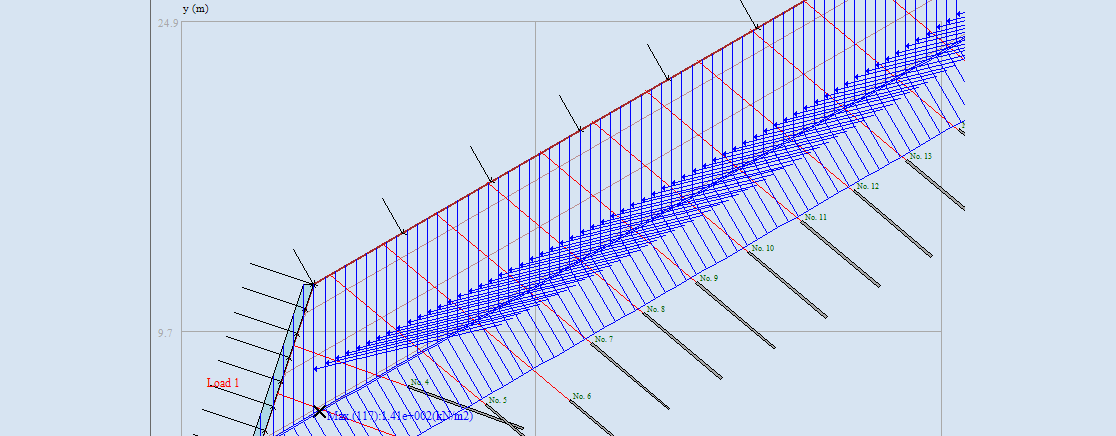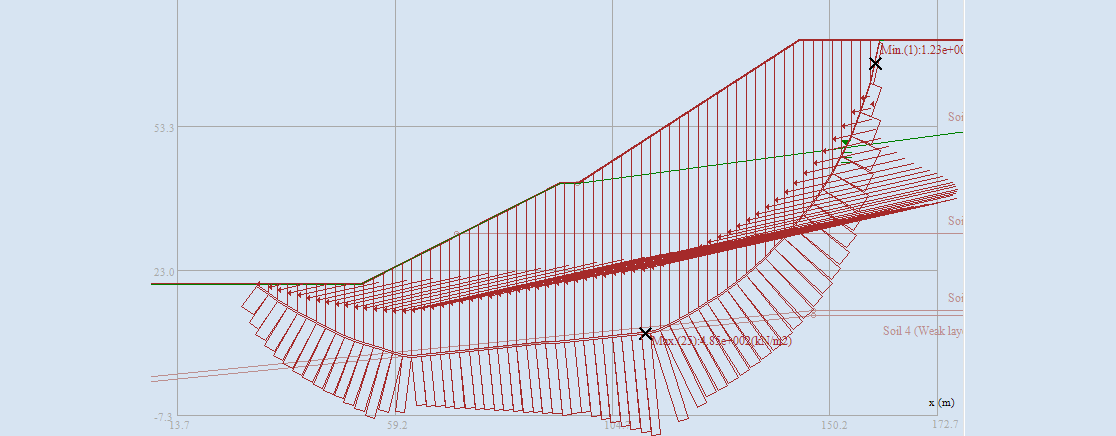Introduction to SLOPE-ffdm 2.0
SLOPE-ffdm 2.0 簡介
SLOPE-ffdm 2.0 是基於 FFDM (Force-equilibrium-based Finite Displacement Method) 的先進邊坡穩定分析工具, 由國立成功大學黃景川教授團隊於 2012 年開發。FFDM 克服極限平衡法 (LEM) 無法評估變位的限制,並具備與 FEM、DEM 相比更高的計算效率與準確性。該方法已在 1995 年阪神地震、1999 年集集地震等案例中驗證其耐震分析能力,並廣泛應用於降雨引發地下水位變動造成地滑之研究。
BACKGROUND OF SLOPE-ffdm 2.0
發展背景
To transcend the limitations of traditional limit-equilibrium-based slope stability analysis methods, the Force-equilibrium-based Finite Displacement Method (FFDM) was developed in 2012 by Dr. C.-C. Huang at the Department of Civil Engineering, National Cheng Kung University in Tainan, Taiwan. FFDM transforms conventional slope stability analysis into a displacement-based approach by integrating a stress-displacement constitutive law into the force equilibrium of sliced soil masses.
FFDM serves as the core of the previous iteration of SLICE-DISP program, which has been employed in preliminary studies on groundwater-table-induced slope displacements. Follow-up experimental studies, including direct shear tests and back-analyses of slope failures, have further validated FFDM’s effectiveness in predicting slope displacements caused by internal and external factors.
A significant enhancement in FFDM involves its treatment of the transition from pre-peak to post-peak states along the displaced slip surface, incorporating the classic Versoria curve, also known as the Witch of Agnesi. This integration provides a refined approach to analyzing progressive failure mechanisms in soil slopes.
With the support of these studies and the inclusion of a user-friendly, window-based interface, the latest iteration—SLOPE-ffdm 2.0—offers an advanced analytical tool for slope stability assessment and displacement prediction.
Applications of SLOPE-ffdm 2.0
SLOPE-ffdm 2.0 應用
Predicting Slope Displacements & Settlements
SLOPE-ffdm 2.0 enables accurate calculations of potential slope displacements and settlements, considering geological conditions, groundwater table variations, and seismic influences.
Evaluating the Performance of Different Facing Types
The effectiveness of various facing types—including gravity walls, modular blocks, and gabions—can be assessed through displacement-based performance analysis, ensuring stability optimization.
Estimating Mobilized Reinforcement Forces
For reinforced and nailed soil structures, FFDM estimates mobilized reinforcement forces as part of the analytical output, replacing empirical input-based reinforcement forces used in conventional LEM analysis.
Optimizing Reinforcement Configurations
The system assists in optimizing reinforcement configurations, determining the ideal number of layers, reinforcement locations, and orientations for enhanced structural integrity.
Identifying Critical Failure Mechanisms in Anchored Slopes
FFDM enables detailed failure mechanism analysis in slopes stabilized with ground anchors and RC girder systems, providing a deeper understanding of slope stability control factors.
Determining Optimal Ground Anchor Configurations
The methodology supports precise ground anchor configuration design, optimizing anchor quantity, tendon length, pre-stress intensity, and dip angles to maximize slope stability.
Assessing Seismic Resistance Through Displacement Response Curves
Displacement response curves generated via FFDM displacement analysis allow for evaluating the seismic resistance of slopes and soil-retaining structures, enhancing earthquake resilience planning.
Back-Calculating Material Properties for Landslide Analysis
FFDM facilitates back-calculation of material properties in slopes composed of disintegrated rock materials, offering valuable insights into potential future landslide occurrences.
This approach eliminates the technical challenges associated with undisturbed soil sampling in slopes consisting of fragmented rock masses.
WHY USE SLOPE-ffdm 2.0
為何選用 SLOPE-ffdm 2.0
Built upon the core principles of FFDM, the program SLOPE-ffdm 2.0 introduces several features that set it apart from conventional slope stability analysis methods, including the limit equilibrium method (LEM), finite element method (FEM), and discrete element method (DEM):
1. Accurate Displacement Prediction:
- FFDM provides precise and practically significant slope displacement estimates, ranging from 10⁻⁴ to 10⁻¹ meters, spanning four logarithmic cycles.
- Unlike LEM-based analyses, which rely on empirical safety factors for decision-making, FFDM offers a direct and quantifiable displacement prediction approach.
- Compared to FEM analysis using strength reduction techniques, FFDM simplifies verification and problem-solving processes, enhancing efficiency.
2. Streamlined Input Requirements and Computational Speed:
- FFDM requires only three input soil parameters to capture nonlinear displacement responses to slope condition changes.
- The computational time for FFDM displacement analysis is comparable to conventional LEM-based safety factor assessments yet significantly faster than FEM and DEM, which often require hours—or even tens of hours—per case, especially when incorporating nonlinear soil stress-strain behavior.
3. Reduced Input Data for Failure Surface Analysis:
- By focusing on the stress-displacement response along the potential failure surface, FFDM minimizes required input parameters compared to FEM and DEM.
- In back-analysis cases, where soil parameters are derived from observed slope displacements, FFDM offers a substantial advantage over FEM and DEM by providing a more direct and efficient approach.
4. Efficient Validation Process:
- FFDM significantly reduces the time required for validating analytical outputs compared to FEM and DEM.
- The streamlined input requirements allow faster assessments of critical failure zones, improving practical applicability.
5. Versatile Batch Simulation Capabilities:
- Batch Job Modes: Systematic parameter adjustments allow multiple cases to be analyzed efficiently. These automated simulations can run for hours or days, with results stored systematically, broadening research perspectives.
- Multi-Method Comparison: Each trial-and-error or designated failure surface undergoes analysis using two to three different methods, including Fellenius, Bishop, Janbu, Spencer, and multi-wedge techniques.
- This eliminates biases in method selection and reveals the strengths of various approaches under specific geological and loading conditions, leading to more informed final decisions.
6. Displacement-Based Evaluation of Retaining Structures:
- For projects using soil-retaining structures for slope stabilization, FFDM enables displacement-based assessments of structural contributions to overall stability.
- Three types of facing structures—gravity walls, stacked modular blocks, and stacked gabions—can be analyzed for inter-block, along-the-base, and above-facing failure mechanisms using displacement modeling.
7. Reinforcement Interaction Analysis for Geosynthetic and Steel-Strip Walls:
- FFDM incorporates a displacement-based pullout model to evaluate the interaction between reinforcement materials and facing structures.
- The methodology assesses pullout behavior from both the facing blocks and the backfill soil using a comprehensive database of reinforcement materials, optimizing slope stabilization analysis.
8. Anchored Slope Stability Analysis:
For slopes stabilized with a pre-stressed ground anchor and RC girder facing system, SLOPE-ffdm 2.0 introduces three analytical approaches to assess potential failure mechanisms induced by anchor pre-stress. This advanced methodology offers a displacement-based perspective for evaluating anchored slopes, enhancing accuracy in stability predictions and structural assessments.
9. Stress-Displacement Evolution Along Failure Surfaces:
The entire evolutionary process of stress-displacement in soils along a failure surface can be captured using a hyperbolic stress-displacement curve for pre-peak and peak states, and a Versoria curve for post-peak conditions. This analytical framework allows deeper exploration into soil strength deterioration along the sliding path, helping to identify the dominant factors influencing slope failures.
10. Analysis of Slope Anti-Sliding Piles Based on Displacement Criteria:
Slope anti-sliding piles are displacement-sensitive structures that involve interaction between the slope and the pile body. Traditional design methods for slope anti-sliding piles are based on empirical assumptions regarding earth pressure distribution, often neglecting the development of pile resistance following displacement. Using SLOPE-ffdm 2.0, under conditions ensuring displacement compatibility between the slope and pile body, the model accounts for both earth pressure and the internal stress development within the pile, making it an effective analytical tool. This analysis module will be included in the next version of SLOPE-ffdm.
System Features
系統特點
FFDM自發展初期至今13年除了上述之驗證案例外本研究室亦致力於建立土壤之非線性強度參數與加勁材料在土體中
抗拉拔(Pull-out resistance) 行為之模式化與力學參數資料庫之建立 成為最新版程式 SLOPE-ffdm 2.0 之強力後盾
注重時間效益之分析
相較於有限元素法,SLOPE-ffdm 2.0 在極短時間內即能完成非線性邊坡變形分析,效率極高。
各種外力條件下之滑動位移模擬
模擬自然或人造邊坡在移除坡腳、外加荷重或地下水位變化時的滑動行為。
地震變位反應曲線
以變位為基準直接輸入最大加速度,準確分析地震下邊坡變形,減少對經驗法則的依賴。
擋土牆型式比較分析
可分析多種擋土牆型式(如重力式、疊砌塊石、蛇籠)對邊坡穩定的影響,提供選擇依據。
擋土面牆選用依據
利用面牆內外部參數調整,模擬擋土牆對滑動行為與破壞型態的影響 ,選擇最佳型式。
邊坡變位反算與預測
針對岩土交界區進行反分析,有效取得滑動面力學參數,預測未來變位行為。
多種破壞面與分析法整合
支援圓弧螺線楔形多段線與複合形等破壞面形式分析。
經過驗證之材料參數
所使用材料力學參數經過實驗與實例驗證,提升分析可靠度與準確性。
加勁土壤構造物分析
分析以地工合成物鋼材或土釘 為加勁材料之邊坡及擋土設施受力變位行為 並提供最佳之材料配置。
預力地錨邊坡分析
考慮預力地錨之可能發生破壞機制 對於以地錨加強之邊坡 提供以變位為基準之系統健全度檢討。



